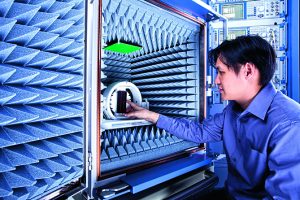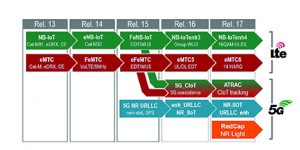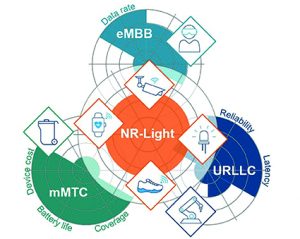 Recently the cellular IoT (C-IoT) ecosystem, and especially the 3GPP standardisation, has focused on enabling the massive machine type communication (mMTC) market for applications such as water metering, cow monitoring, smart parking or asset tracking. The base technologies narrowband Internet of Things (NB-IoT) (Cat-NB1/2) and enhanced machine type communication (eMTC) (Cat-M) were developed in Rel. 13/14, with dedicated features for very low power consumption (extended discontinuous reception (eDRX), power supply module (PSM)) and coverage enhancements (CE modes). In the meantime, around 140 mobile operators around the world have deployed LTE M or NB-IoT networks, and GSA (Global mobile Suppliers Association) has counted more than 500 devices supporting either Cat-M1, Cat-NB1 or Cat-NB2.
Recently the cellular IoT (C-IoT) ecosystem, and especially the 3GPP standardisation, has focused on enabling the massive machine type communication (mMTC) market for applications such as water metering, cow monitoring, smart parking or asset tracking. The base technologies narrowband Internet of Things (NB-IoT) (Cat-NB1/2) and enhanced machine type communication (eMTC) (Cat-M) were developed in Rel. 13/14, with dedicated features for very low power consumption (extended discontinuous reception (eDRX), power supply module (PSM)) and coverage enhancements (CE modes). In the meantime, around 140 mobile operators around the world have deployed LTE M or NB-IoT networks, and GSA (Global mobile Suppliers Association) has counted more than 500 devices supporting either Cat-M1, Cat-NB1 or Cat-NB2.
Emerging IoT applications in several industries, as well as the global phase out of 2G and 3G networks, drive the need for more application-specific extensions. Therefore, 3GPP is continuously working on improvements for NB-IoT and eMTC to cover specific application demands (Figure 1). Examples are wake-up signals or early data transmission, as introduced in Rel. 15. Both help to optimise power consumption and reaction times. In the long term, however, there is a need for a smooth transition to the era of 5G.
C-IoT in the era of 5G
The first mobile network generation designed from the start to support not only the mobile broadband market (eMBB), but also the growing IoT market was 5G. Already in the first 5G release, the foundation was laid for the transition of mMTC (NB-IoT/eMTC) from 4G to 5G and for so-called ultra reliable, low latency communication (URLLC) demanded by, for example, factory automation. Some 5G new radio (NR) characteristics such as flexible numerology, wide frequency support, built-in security and several layers of virtualisation create the base to support essential 5G use case scenarios of eMBB, mMTC and URLLC.
Two factors are essential for the future of mMTC in the 5G era: the co-existence of NB-IoT and eMTC in 5G due to flexible use of radio resources; and the support of related features by the 5G core. Co-existence features as specified in Rel. 16 will allow 5G capable NB-IoT and eMTC devices to connect to a standalone 5G network.
Industrial IoT
Factories in the future will rely on deep integration of information and automation, enabled by ubiquitous connectivity. The industry is looking for a reliable and secure wireless communication technology that can be used for different applications on the factory floor. There might be alternatives to address different cases, but only 5G has the potential to address them all.
 5G mMTC is optimised for low power and deep coverage for devices that track tools and goods or it can be used for connecting sensors.
5G mMTC is optimised for low power and deep coverage for devices that track tools and goods or it can be used for connecting sensors.
5G eMBB is optimised for mobility and high data throughput. It is suitable for use in connecting virtual reality glasses and handheld devices used around the factory floor.
A new feature in 5G URLLC, developed in Rel.16/17, will enable full automation for controlling robots or automated guided vehicles.
URLLC is a new application area for cellular communication with explicit requirements regarding latency, timing and reliability. 3GPP has spent reasonable efforts to address these requirements and now provides a comprehensive URLLC toolset. It will help optimise the latency on the radio interface, with features such as short symbol time and mini slots, together with enhancements such as fast and flexible repetition process or grant-free uplink transmission. Network virtualisation, traffic prioritisation and multi-access edge computing will largely improve the end-to-end latency. Communications reliability can be improved by applying robust coding schemes, packet duplication and repetition as well as dual connectivity schemes. This toolset includes the support of time-sensitive networks or LAN-type services via 5G, as mainly developed in Rel.16. Further improvements for time synchronisation or operation in unlicensed environments are in development in Rel.17.
Besides latency and communication reliability, network availability and security are critical for mission- and business-critical applications in the industrial environment. The industry has therefore been looking to operate private 5G networks that could be deployed as standalone non-public networks (NPNs) using private spectrum or public network integrated NPNs using network virtualisation as specified in Rel.16.
Introducing NR Light
The comprehensive feature set of 5G adequately addresses a wide range of IoT applications, for example, those for extreme low-cost, extreme low-power and limited mobility with NB-IoT. There are, however, plenty of IoT applications, children’s safety wearables, for example, that need long battery lifetime, very good coverage, as well as full mobility and reasonable data rates. Other examples are emergency sensors that need extreme coverage, but also very low latency and low power consumption. To address these mid-range IoT applications, 3GPP started to study the application requirements under the name NR Light. In Rel. 17 it is going to standardise a new reduced capability device type with the focus on the typical requirements of industrial sensors, smart wearables and surveillance cams (Figure 2).
Non-terrestrial networks
Today, mobile networks can cover more than 80% of the global population but only 40% of the land surface and less than 20% of the Earth’s surface. The only worthy alternative to addressing IoT applications of global sensing, tracking and monitoring is the use of non-terrestrial networks by using, tiny low earth orbit satellites. In Rel. 17, 3GPP is working on the integration of satellite components in the 5G NR architecture in general. Initially, it studies the use of long-term evolution based NB-IoT and eMTC via non-terrestrial networks.
The power of testing
3GPP is continuously driving standardisation to meet present and future requirements for the IoT ecosystem. The large diversity of features and network scenarios, together with very specific IoT application requirements, will accelerate demand for test and certification over the lifecycle of devices and network components.
 Latency, reliability and power consumption become increasingly important and continuous monitoring of networks will become essential. As a result, wider IoT testing faces a broad range of challenges from performance measurements, such as power consumption and battery life, through compliance and manufacturing test, deployment and operations to servicing and in-service repair.
Latency, reliability and power consumption become increasingly important and continuous monitoring of networks will become essential. As a result, wider IoT testing faces a broad range of challenges from performance measurements, such as power consumption and battery life, through compliance and manufacturing test, deployment and operations to servicing and in-service repair.
It follows that battery life requirements of more than 10 years and latency requirements ranging from minutes to microseconds become relevant. Some applications requiring global coverage and mobility will focus on cellular technologies such as LTE-M and NB-IoT, but most devices will use non-cellular wireless technologies such as Bluetooth, Wi-Fi, ZigBee, THREAD, EnOcean, Sigfox and LoRa in unlicensed industrial, scientific and medical/short range tbands.
Test challenges in RF design
Testing the overall communication behaviour of IoT devices is an important topic in all phases of the product lifecycle. RF design requires special attention. IoT device measurements typically start with RF power, spectrum and receiver sensitivity measurements in connected mode. S-parameters are measured to verify and tune the antenna performance of the IoT device.
After this, over-the-air measurement of the total radiated power and total isotropic sensitivity of the final design is recommended. It may also be relevant to perform measurements under certain fading conditions or apply coverage enhancement techniques such as those used for NB-IoT and LTE-M devices.
Designing appropriate hardware and software is especially important for low power devices, for example implementing optimal power consumption in active mode, but also deep-sleep modes or short startup/shutdown phases. IoT devices that use wireless low-power technologies (LP-WAN) such as LTE-M or NB-IoT need to consider all aspects of the operational modes and features such as PSM, eDRX or CE.
Device makers, operators and infrastructure manufacturers require a comprehensive test portfolio to accelerate the introduction of IoT applications and services. This cannot be achieved without verifying conformance of IoT devices with regulatory, operator and standards requirements.
Even with well-defined processes, many new designs of IoT devices still fail certification at the first attempt. Regulators have defined test cases to ensure co-existence and network-friendly operations for wireless technologies operating in the same frequency band. Bluetooth, Wi-Fi and ZigBee, for example, all operate in the same 2.4GHz ISM band. Their certification focuses on RF and protocol conformance topics to ensure interoperability and high performance. Operators may request additional tests authorising IoT devices for their networks.

